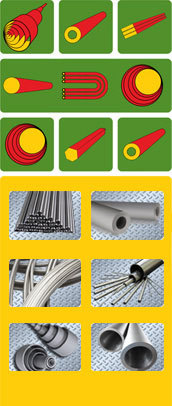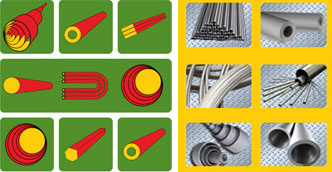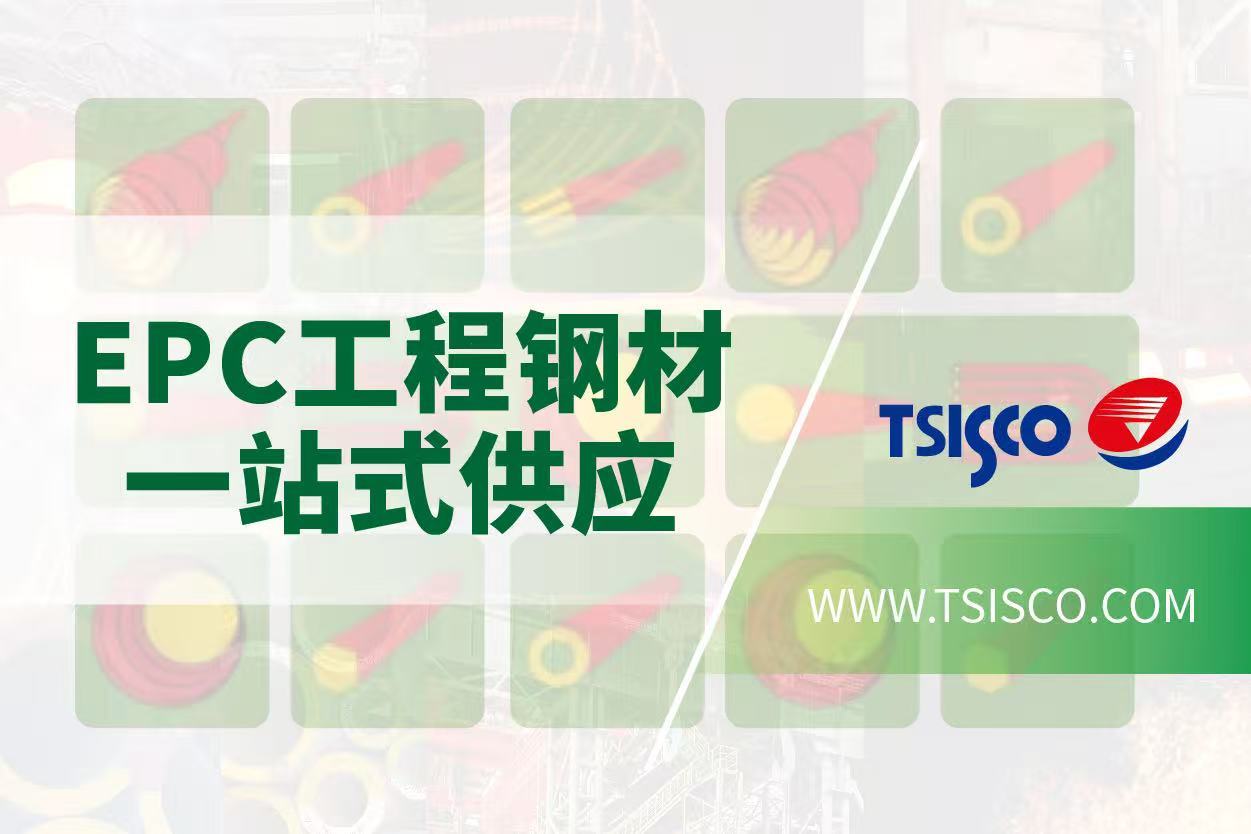-
Products & Solutions
Industrial Heater Tubing
Industrial Heater Tubing

Industrial Heater Tubing
Meta Title (≤60): Industrial Heater Tubing | Materials & Sizes for Electric, Fired & Exchanger Heaters
Meta Description (≤160): Complete, no-gap guide to heater tubes: materials (carbon/alloy/stainless/nickel), size and quantity ranges, quick sizing rules, ready-to-spec ranges and BOM checklist.
Keywords: fired heater coils, radiant tubes, convection banks, electric heater sheath, boiler tubes, shell-and-tube exchanger, T11, T22, 321H, Alloy 800H, Inconel 600/625, Hastelloy C-276, Duplex 2205/2507
1) Heater Types & Principles
Electric Heaters – tubular / flange / circulation; electricity → heat; petrochem, power, food, pharma.
Fired Heaters / Furnaces – crude/hydrotreater/cracking; gas or oil fired; radiant & convection tube heating.
Heat-Exchanger Heaters – steam/thermal-oil media; boilers and process line heating.
2) Materials for Heater Tubes
Carbon Steel – 20#, Q345R, ASTM A106 Gr.B, API 5L; ≤450 °C low-corrosion duties.
Low Alloy Steel – 12Cr1MoV, 15CrMo, T11, T22; 500–600 °C, boilers & radiant coils.
Stainless Steel – 304/304H, 321H, 316/316L, 347H; 600–800 °C, oxidation/corrosion resistant.
Nickel Alloys – Inconel 600/625, Alloy 800H/825, Hastelloy C-276; ≥900 °C, severe Cl⁻/H₂ service.
Clad/Lined Tubes – CS base + SS/Nickel lining for combined high-temp & corrosion.
Severe corrosion tip – choose Duplex 2205/2507 or Nickel alloys for chloride/acid service.
3) Size & Quantity Ranges by Heater Type
A) Fired Heaters
Radiant coils – OD 3”–8” (typ. 4”–6”), WT 6–25 mm, L 8–14 m, ~50–300 pcs, total length up to km-scale.
Convection banks – OD 1½”–3”, WT 3–8 mm, 200–800 pcs, total 1–6 km; finned tubes optional.
Cross-over/headers – NPS 6”–24” (DN150–DN600).
Materials – CS/Cr-Mo (T11/T22/P11/P22), SS 304/321/347, Nickel 800H/625.
B) Electric Heaters (flange/circulation/immersion)
Sheath tubes – OD 8–25 mm (typ. 12/16/19/22), WT 1.0–2.5 mm, L 0.5–6 m;
power per element 3–18 kW (up to 30–60 kW with surface-load control).
Shell vessels – DN150–DN600; nozzles DN25–DN300; flange heaters DN80–DN300.
Materials – Sheath 304/316L, Incoloy 800/825, Inconel 600/625; shells CS/SS; for chlorides/acids use 2205/2507 or C-276.
C) Boilers / Power Plants
Superheater/Reheater – OD 38–60 mm (typ. 50.8 mm), WT 5–12 mm; total length: thousands to tens of thousands of meters.
Economizer – OD 32–42 mm; thousands of tubes.
Air preheater/flue-gas surfaces – similar ranges / finned tubes.
Materials – 20G/SA-210/SA-213-T11/T22; T91/T92 for ultra-supercritical; SS in corrosive zones.
D) Shell-and-Tube Process Heaters
Tubes – OD 19 mm (3/4”) or 25.4 mm (1”), WT 1.65–2.11 mm (BWG 14–12), L 3–9 m;
Quantity – 100–3,000 tubes per unit;
Shells – DN400–DN2600;
Materials – CS, SS, Duplex 2205/2507, Nickel alloys.
4) Quick Sizing Rules (Pre-FEED)
Electric circulation heater
• Elements: n ≈ P_total / P_unit (round up; 3-phase grouping; N+1 redundancy).
• Sheath length: L_total ≈ n × 2–4 m.
• Shell DN from flow & allowable velocity (liquid 0.5–2 m/s; gas 5–15 m/s).
Example: 3 MW, 18 kW/element → n≈167; if 2.5 m each → ≈418 m sheath; shell DN400–DN600.
Fired heater radiant section
• Required area A ≈ Q(MW)×1000 / q″(kW/m²).
• For OD 114.3 mm, effective length 12 m, per-tube area ≈ 4.31 m².
• Example 50 MW, q″=40 → A≈1250 m² → ~290 tubes; add 2”–3” convection tubes 300–600 pcs.
5) Ready-to-Spec Ranges
• Radiant tubes: OD 4”–6”, WT 8–18 mm, 10–14 m; P22/321H/347H/800H; 100–300 pcs.
• Convection tubes: OD 2”–3”, WT 3–6 mm, 6–9 m; CS/SS; 200–800 pcs.
• Electric heater sheath: OD 12–22 mm, WT 1.0–2.0 mm, 2–4 m; 316L/800/600; dozens–hundreds of pcs.
• Boiler heat-transfer tubes: OD 38–60 mm, WT 5–12 mm, 6–12 m; total length in the thousands–tens of thousands of meters.
• Shells/Nozzles: Shell DN400–DN2400; Nozzles DN25–DN300.
6) BOM & Purchasing Checklist
1. Duty (MW/kW), medium, inlet/outlet T&P.
2. Selection: radiant/convection sizes & materials; electric element OD/power/qty; shell & nozzle DN.
3. Geometry: effective length per tube, total count, heat-transfer area.
4. Piping: elbows/tees/headers/flanges (ASME B16.5/B16.9/B16.11, Class 150–2500).
5. Protection & QA: coatings (FBE/metal spray/zinc-rich), NDT (UT/RT/PMI), hydrotest.
Industrial Heaters are widely used process-heating devices across energy, chemical, power generation, and metallurgical industries. Their essential functions are to:
• Convert electrical power, fuels (natural gas/oil), steam, or other energy sources into heat;
• Transfer that heat to process media (gases, liquids, steam, process fluids) via heating elements, tubes, or furnace chambers.
🔥 Main Types of Industrial Heaters
1. Electric Heaters
• Tubular Heaters
• Flange Heaters
• Circulation Heaters
→ Directly convert electrical energy into heat; widely used in petrochemical plants, power stations, food, and pharmaceutical industries.
2. Fired Heaters / Furnaces
• Common in petrochemicals (crude preheaters, gas heaters, cracking furnaces, hydrotreating furnaces)
• Burn natural gas/oil and heat the fluid through radiant and convection coils.
3. Heat-Exchanger Heaters
• Use steam or thermal oil to heat the process medium; common for boilers and process line heating.
🏗️ Common Pipe Materials for Industrial Heaters
Material selection varies significantly by temperature, pressure, and corrosiveness of the medium.
1. Carbon Steel
• Typical grades: 20#, Q345R, ASTM A106 Gr.B, API 5L
• Features: cost-effective; suitable for ≤ 450 °C and low-corrosion service
• Uses: boiler waterwalls, steam lines, convection banks in fired heaters
2. Low Alloy Steel
• Grades: 12Cr1MoV, 15CrMo, T11, T22 (ASME SA213 series)
• Features: creep resistance; high-temperature capability (500–600 °C)
• Uses: power-plant boilers, radiant coils in petrochemical heaters, superheater tubes
3. Stainless Steel
• Grades: 304/304H, 321H, 316/316L, 347H
• Features: corrosion resistance and high-temperature oxidation resistance; typical 600–800 °C
• Uses: petrochemical furnace tubes, electric heater sheaths, heating of aggressive media
4. Nickel-Based Alloys
• Grades: Inconel 600/625, Alloy 800H/825, Hastelloy C-276
• Features: withstand ≥ 900 °C; strong resistance to chlorides
• Uses: ethylene cracking furnaces, hydrogen heaters, electric heaters in extreme service
5. Clad & Lined Pipes
• Construction: carbon-steel base pipe + stainless/nickel-alloy liner
• Use: high-temperature and corrosive environments to balance performance and cost
📌 Quick Summary
• Conventional boilers/steam heaters → Carbon steel, low alloy steel
• Petrochemical cracking / high-temperature fired heaters → Cr-Mo alloys, stainless, nickel alloys
• Electric heating element sheaths → 304/316L, Incoloy 800, Inconel 600
• Strongly corrosive media (acids, salt mist, chlorides) → Duplex 2205/2507, nickel-based alloys
I. Typical Pipe Sizes & Quantity Ranges by Heater Type
A) Fired Heaters / Furnace Coils
(Crude heaters, hydrotreaters, cracking furnaces — radiant & convection sections)
Radiant Coils
• OD: 3”–8” (88.9–219.1 mm); typical 4”–6”.
• WT: 6–25 mm (varies with pressure/temperature/material; thicker for H₂ service & high temp).
• Single length: 8–14 m per tube (set by firebox height; multiple tubes in series/parallel “coils”).
• Order of magnitude: ~50–300 radiant tubes are common; total length from hundreds of meters to several kilometers.
Convection Bank
• OD: 1½”–3” (48.3–88.9 mm); finned tubes optional.
• WT: 3–8 mm (heat-transfer driven, lower pressure).
• Order of magnitude: ~200–800 tubes; total length 1–6 km.
Cross-over / Interconnecting Pipes & Headers
• NPS: 6”–24” (DN150–DN600) commonly used; sized by flow.
Material note: Carbon steel / Cr-Mo (T11/T22/P11/P22), Stainless 304/321/347, Nickel alloys 800H/625 (for high-temp / chlorides / hydrogen).
B) Electric Heaters (flange, circulation, immersion)
Heating Element Sheath
• OD: 8–25 mm (common: 12, 16, 19, 22 mm).
• WT: 1.0–2.5 mm (stainless / nickel-alloy sheath).
• Unit power: 3–18 kW per element (typical industrial); high-power up to 30–60 kW/element (surface-load limited).
• Element length: 0.5–6 m; straight or U-bent.
• Quantity estimate: number of elements ≈ total heater power ÷ unit power (then check wiring & redundancy).
Circulation Type (with pressure vessel)
• Shell/nozzle pipe: 6”–24” (DN150–DN600) or a small vertical vessel.
• Inlet/Outlet nozzles: 1”–12” (DN25–DN300) sized by flow/ΔP.
Flange Heaters
• Heating elements per above; flange size often DN80–DN300.
Material note: Sheath 304/316L, Incoloy 800/825, Inconel 600/625; shells in carbon steel/stainless. For chlorides/acid service choose Duplex 2205/2507, Hastelloy C-276.
C) Boilers / Power-Plant Heaters
(Superheater, reheater, economizer, air preheater)
Waterwall / Superheater / Reheater Tubes
• OD: ∅38–∅60 mm (typical 50.8 mm).
• WT: 5–12 mm.
• Order of magnitude: total tube length in the thousands to tens of thousands of meters per boiler.
Economizer
• OD: ∅32–∅42 mm.
• Order of magnitude: thousands of tubes.
Air preheater / flue-gas heating surfaces
• Similar diameters or finned tubes.
Material note: 20G / SA-210 / SA-213-T11/T22; T91/T92 for ultra-supercritical; stainless in corrosive zones.
D) Shell-and-Tube Process Heaters (steam / thermal-oil)
Heat-exchange Tubes (standard)
• OD: 19 mm (3/4”) or 25.4 mm (1”) most common.
• WT: 1.65–2.11 mm (BWG 14–12).
• Tube length (TL): 3–9 m.
• Order of magnitude: 100–3,000 tubes per unit (by required area).
• Tubesheet/shell: Shell diameters typically DN400–DN2600.
Material note: Carbon steel, stainless steel, Duplex 2205/2507, nickel alloys (acidic/chloride/high-temp service).
II. Quick Sizing Methods (Early Estimates)
1) Electric Circulation Heater — Back-of-the-Envelope
• Given: total power P_total (kW); choose element rating P_unit (kW/element).
• Elements: n ≈ P_total / P_unit (round up; balance across 3-phase; add N+1 redundancy).
• Total sheath length: assume 2–4 m/element ⇒ L_total ≈ n × L_unit.
• Shell DN: infer from flow and allowable velocity (liquid 0.5–2 m/s; gas 5–15 m/s).
Example: 3 MW circulation heater, P_unit=18 kW → n≈167 elements.
If 2.5 m/element → ≈418 m total sheath length. Shell DN 400–600, then verify by ΔP.
2) Fired Heater (Crude Heater) — Radiant Section First-Pass
• Given: duty Q (MW), allowable surface heat flux q″ (~20–60 kW/m² per heater design).
• Required area: A ≈ Q × 1000 / q″ (m²).
• Pick OD=114.3 mm (4½”), effective heated length L_eff; per-tube area ≈ π·OD·L_eff.
• Tube count: n ≈ A / (π·OD·L_eff) → round up and distribute by circuits.
• Convection bank: add area per process need (often radiant:convection ≈ 60:40, flowsheet dependent).
Example: 50 MW crude heater
• Take q″=40 kW/m² → A_rad ≈ 1250 m².
• With OD 114.3 mm and L_eff=12 m → per tube ≈ 4.31 m².
• Radiant tubes: n ≈ 1250 / 4.31 ≈ 290 tubes (split into 5–6 parallel circuits).
• Convection: add 2”–3” tubes ~300–600 pcs.
These are screening estimates; final design must check fluid properties, allowable ΔP, coking/erosion, thermal expansion stress, firebox layout, and governing codes.
III. Ready-to-Spec Ranges (Good for RFQ/Bid Tabs)
• Radiant tubes: OD 4”–6”, WT 8–18 mm, 10–14 m long; P22/321H/347H/800H; 100–300 pcs.
• Convection tubes: OD 2”–3”, WT 3–6 mm, 6–9 m long; CS/SS; 200–800 pcs.
• Electric heater sheath: OD 12–22 mm, WT 1.0–2.0 mm, 2–4 m; 316L/800/600; dozens–hundreds of elements (by power).
• Boiler heat-transfer tubes: OD 38–60 mm, WT 5–12 mm, 6–12 m; total length in the thousands–tens of thousands of meters.
• Shells / nozzles: DN400–DN2400 shells; DN25–DN300 nozzles (circulation/flange heaters).
IV. BOM / Purchasing Checklist
1. Heater duty (MW/kW), medium, inlet/outlet pressure & temperature.
2. Selection: radiant/convection tube sizes & materials; electric element OD, unit kW & quantity; shell/nozzle DNs.
3. Geometry: effective heated length per tube, total tube count, total heat-transfer area.
4. Piping & fittings: elbows/tees/headers/flanges to ASME B16.5/B16.9/B16.11, Class 150–2500.
5. Protection & QA: coatings (FBE/metal spray/zinc-rich primer), NDT (UT/RT/PMI), hydrostatic test.
If you share duty, medium, P/T, and layout limits, I can immediately produce a one-pass sizing & quantity sheet (with material picks and weight estimates) ready for FEED, RFQ, or budgeting.
Tags:











